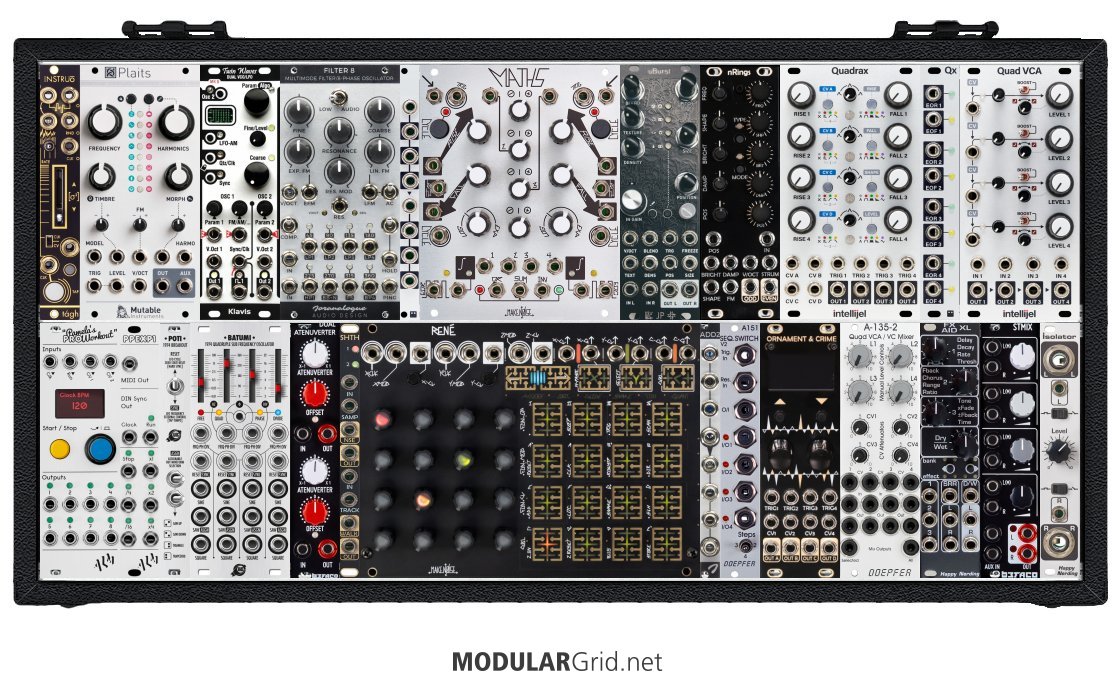Ok, this was a neat challenge. But to be honest, I think my solution might need some work. I like where Sweelinck was headed (particularly with the Morphagene), as well. Maybe one of the real power users will come along and give some suggestions. But let me show you where my thinking is leading, and you can do with that as you will.
For starters, I kept almost all the modules you've already gotten, only switching out your passive mult for a buffered mult. A passive mult does not do as good a job as a buffered when multing signals; if you want to mult 1v/oct signals, you'll want a buffered mult so there is no drop in voltage. Also, I'd get a multi-cable rather than a passive mult, to save space. The other thing to consider is that the Rene, as badass as it is, takes up 32hp. That's pretty dear for a sequencer, even one as powerful as Rene. You have 104 hp to use (if the above case is accurate), don't waste nearly a third of it on a sequencer. Get something off rack like a BSP, or go for a bigger case so you don't have to sacrifice other modules for Rene.
Keeping in mind that you are interested in dark ambient with a hint of generative, I did the following (listed by function).
Top Row: Random voltages, VCOs (3 v/oct ins), multimode filter (2 inputs), mults, Maths (so many functions, but at most basic, a mixer/attenuverter/function generator), audio manipulation in the form of uClouds and uRings, function/envelopes/quad cascading VCA.
Bottom Row: Clocking, modulators, attenuverters, S/H and T/H, sequencer, precision adder, sequential switch, uO_C (so many functions, only two levels of menu diving), and end of chain VCAs, effects, and mixers.
My thought is that you could use the bottom row to supply motion, modulation, attenuation, triggers, gates, and sequences. These can be manipulated or quantized (which Rene can already do, but what if you use you S/H for a melody?) or so many other things using uO_C. After that you have another VCA and then end of chain processing. I give you for effects the Happy Nerding FX Aid XL, which sounds great, though you will want to have a printout of the different settings at hand. There's a new version out with a screen, but you don't have the hp for it at the moment.
The top row has sound sources, giving you 3 digital voices that come out of the VCOs ready to go. However, if you wanted to filter further, the Filter 8 gives you plenty to play with. And Joranalogue always throws extra functionality into their modules. Then Maths, which is so handy it needs its own post. Then sound processing in uClouds and uRings. I generally prefer the real article to clones, but it makes sense with MI's situation and your hp. Finally, function/envelope generation and VCAs to craft the shape of the sound.
My typical approach to building a rack is to try to think through the signal path as I plan. From beginning to end, where might I need to send voltages, or what parameters will I want to mangle? That way I can start thinking about the system as an instrument rather than a collection of modules.
Finally, there are utilities. These are hard to figure out without trying them, unless you're already blessed with electrical engineering experience. I mean, how are you supposed to know that sequential switches can be your best friend when building longer sequences, or that precision adders rock, or that comparators are game changers for generative music? The uO_C, particularly with Hemispheres loaded, gives you a chance to test them all out and decide what you actually need. In general (adapting something Sweelinck said in another thread), if you think of your system as a building, the oscillators, filters, and fancy modules are rooms, but you need the utilities to act as hallways and corridors (and sometimes fun-house mirrors) to get from room to room. I highly recommend looking up some videos about different utilities to get a better sense of what they do. Loopop, Mylarmelodies, and DivKid were sources I went to when I was figuring this out, and I found them invaluable.
Anyways, maybe one of the really experienced folks will tell you something different. But it looks like you're on a good path, you just need to think more about the architecture and connecting pieces of your system.
Good luck!

